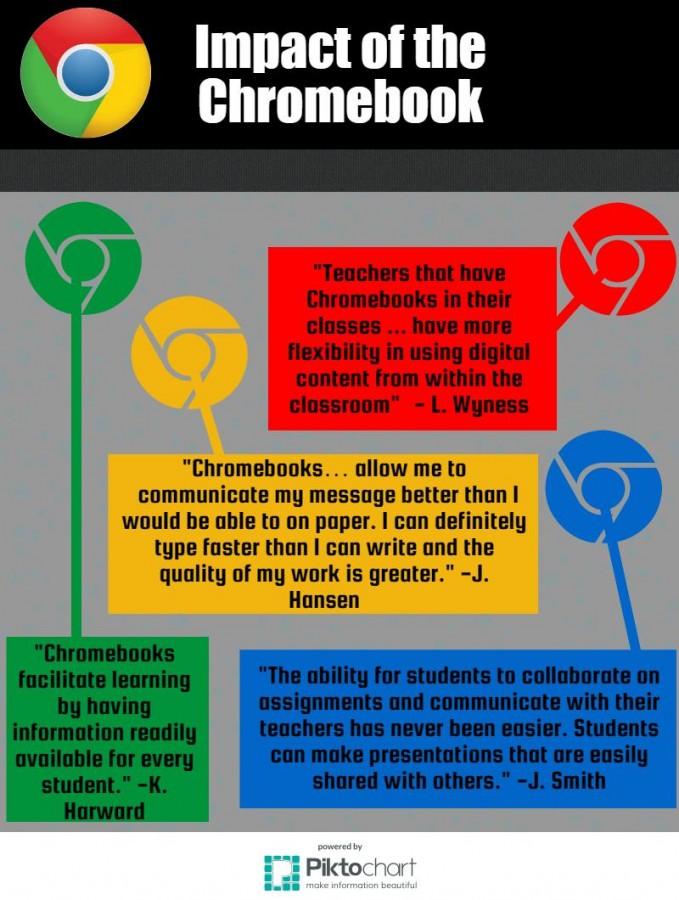Chromebooks invade classrooms
November 12, 2015
Chromebooks first touched down in Granite School District (GSD) in 2012, as part of the Digital Conversion Initiative (DCI), according to Patrick Flanagan, the Head of Educational Technology at GSD.
Flanagan explained that other districts who already had experience with Chromebooks said that “there really have not been any problems,” and that their arrival in GSD “went very smooth without any real large wrinkles that we were not able to overcome.”
Now that Chromebooks have arrived in GSD, Flannagan hopes they will “revitalize [students’] interest in core curriculum, improve technology skills, reduce absenteeism and dropout rate… individualize and accelerate student learning, … enhance teacher proficiency and effectiveness, align curriculum, assessments, and instruction with standards… monitor progress and differentiate instruction.”
Lorraine Wyness, the school’s Library and Media Educational Technology Specialist Coordinator (LMETS), explained that “[in 2013], it was piloted in several English, Math and French classes [in the school]. The district made the decision to put chromebook carts in every English Classroom for the secondary level. As more teachers saw the capabilities and benefits for their classes, we have added carts to nearly every dept.”
The Foreign Language Department was among those most affected by the Chromebook’s arrival. Spanish teacher Jeremy Smith, who allowed Chromebooks a place in his classroom this year, in speaking for the department, said “we decided that Chromebooks would allow us as a department to … have a device each student could use to assist them in their foreign language acquisition and have a place where we could assess students more effectively.”
English is another department that has seen widespread adoption of the Chromebook. AP English teacher and head of the school’s English department, Kevin Harward, who adopted Chromebooks this year, stated “Chromebooks… facilitate research, collaboration, and presentation abilities… Although most use chromebooks for inquiry and research, many teachers use them to collaborate and respond with their peers, using Google Docs, Google Drive, and Gmail. Google Slides are also being used to present, and many teachers are incorporating [a variety of] educational apps.”
Smith, who is optimistic about the newly arrived chromebooks, admits that the devices aren’t perfect. “There are problems, such as poor connectivity and other issues that put a glitch into working with them”
Gunnar Dicou, junior, explained one of these problems. “To use them as efficiently as they meant to be [used] you need wifi to sync to your accounts, [because] without it you can’t download or upload, you can’t access certain apps and you can’t save online.”
And not long ago, the school experienced this when it’s Chromebooks, deprived of their precious wifi, wouldn’t function for most of the day. Despite this, Jarom Hansen, junior, feels that the benefits of Chromebooks outweigh their shortcomings.
He said, “Using the chromebooks really allows someone to self learn, if they don’t understand something [they can] quickly … look it up. and it also allows students to work at their own pace. the faster kids can easily move ahead in the course and the slower kids can move at a comfortable pace for their learning abilities.”
Hansen also described the effect Chromebooks have had on him personally. “Chromebooks… allow me to communicate my message better than I would be able to on paper. I can definitely type faster than I can write and the quality of my work is greater.”
Though many have already formed opinions of the Chromebook, Mr Harward said, “because [Chromebooks are] so new, the jury is still out on whether the increase in using more technology actually increases student learning. We will have to look forward to the future in this regard.”





